 | 01 | The rough Chrysopras has been sliced and a center hole was drilled. |
 | 02 | Thikness about 1.5 cm. |
 | 03 | A large silicon carbide wheel served to shape |
 | 04 | a rough preform, |
 | 05 | and to separate front and back petals. |
 | 06 | The individual petals are roughly modulated. |
 | 07 | The next step is done on a large diamond wheel |
 | 08 | as demonstrated by Katerina Kestemont. |
 | 09 | Here the petals are ground deeper |
 | 10 | and the separation between high and low petals is accentuated. |
 | 11 | I start grinding diagonally between the petal to create the over lapping of them. |
 | 12 | The shape of the petals is not defined yet. |
 | 13 | With a narrow diamond wheel the separation between the petals is ground deeper. |
 | 14 | The flower gets some life. The texture of the coarse diamond wheel can easily be seen. |
 | 15 | Also the back side is carved, taking into account the overall thikness of the flower. |
 | 16 | The next step requires small diamond coated tools with a finer grit. |
 | 17 | At least 3 different shapes are used to schape the surface and the separation between the petals. |
 | 18 | The flower still looks bulky. |
 | 19 | I proceed with a rounded and quite wide grinding tool. |
 | 20 | The surface and also the shape of the petals is defined. |
 | 21 | Nicely seen here the shape of the petals. |
 | 22 | This is still a coarse grinding step and the tool leaves a rough surface. |
 | 23 | Ondulating the petals carefully from the front and backside. |
 | 24 | And then working on the final thikness |
 | 25 | of the petals. |
 | 26 | Working with a very thin diamond blade the separation between the petals is carved to its final depth. |
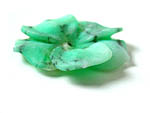 | 27 | I start grinding with silicium carbide wheels which are fashioned into exactly the same shapes as the diamond tools. |
 | 28 | Smoothing the surface first with roundes shapes, and then with narrower and sharper silicon carbide wheels. |
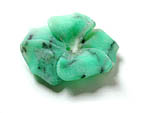 | 29 | At least 2 different smoothing grits are used (400 and 600 mesh) |
 | 30 | All carving traces have to disappear on the front and back side. |
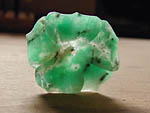 | 31 | The shape has been ground to a thikness where it becomes translucent. Good material without cracks is required. |
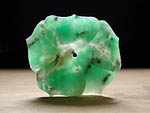 | 32 | The chrysopras flower is ready to undergo the fine grinding (1200 mesh) and final polishing step. |
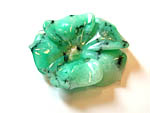 | 33 | This is the reward for several hours of work. |
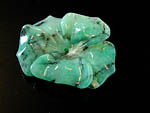 | 34 | The finished chrysopras gemstone carving. |